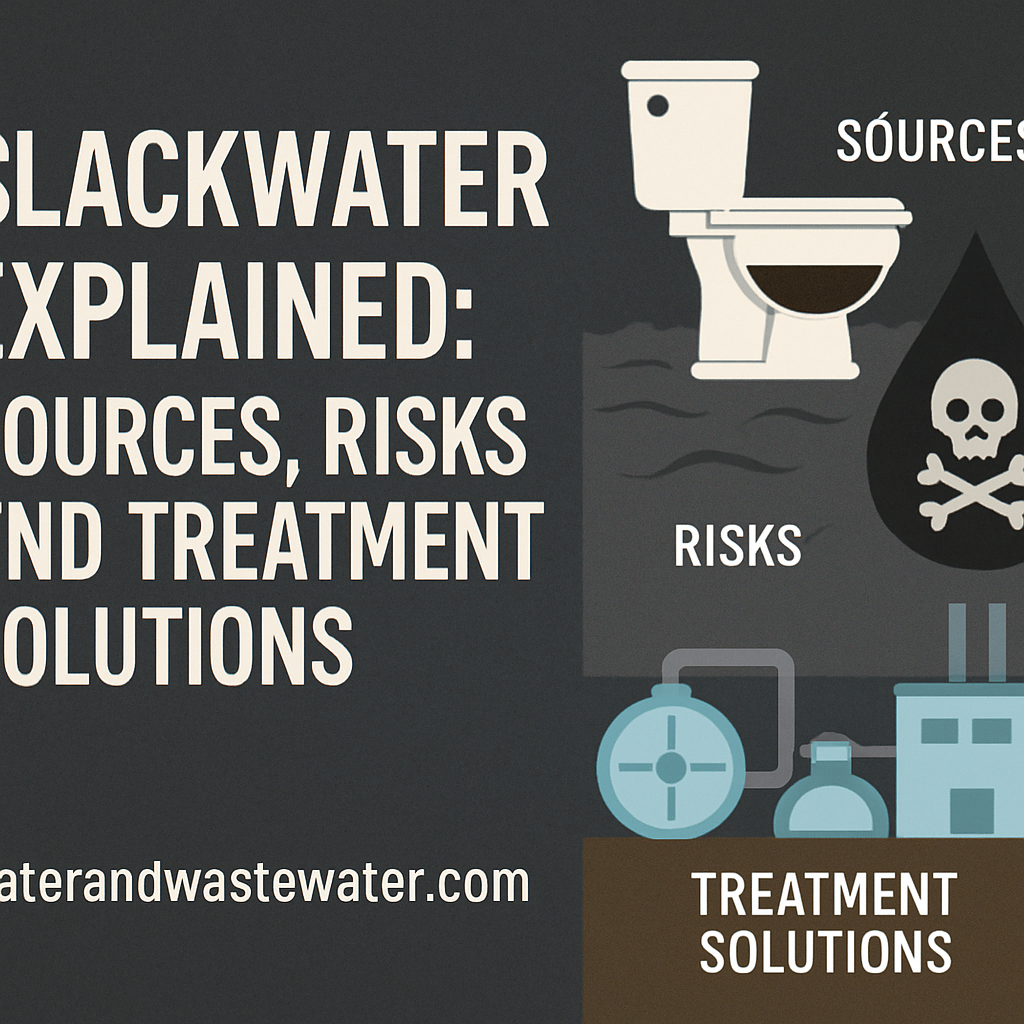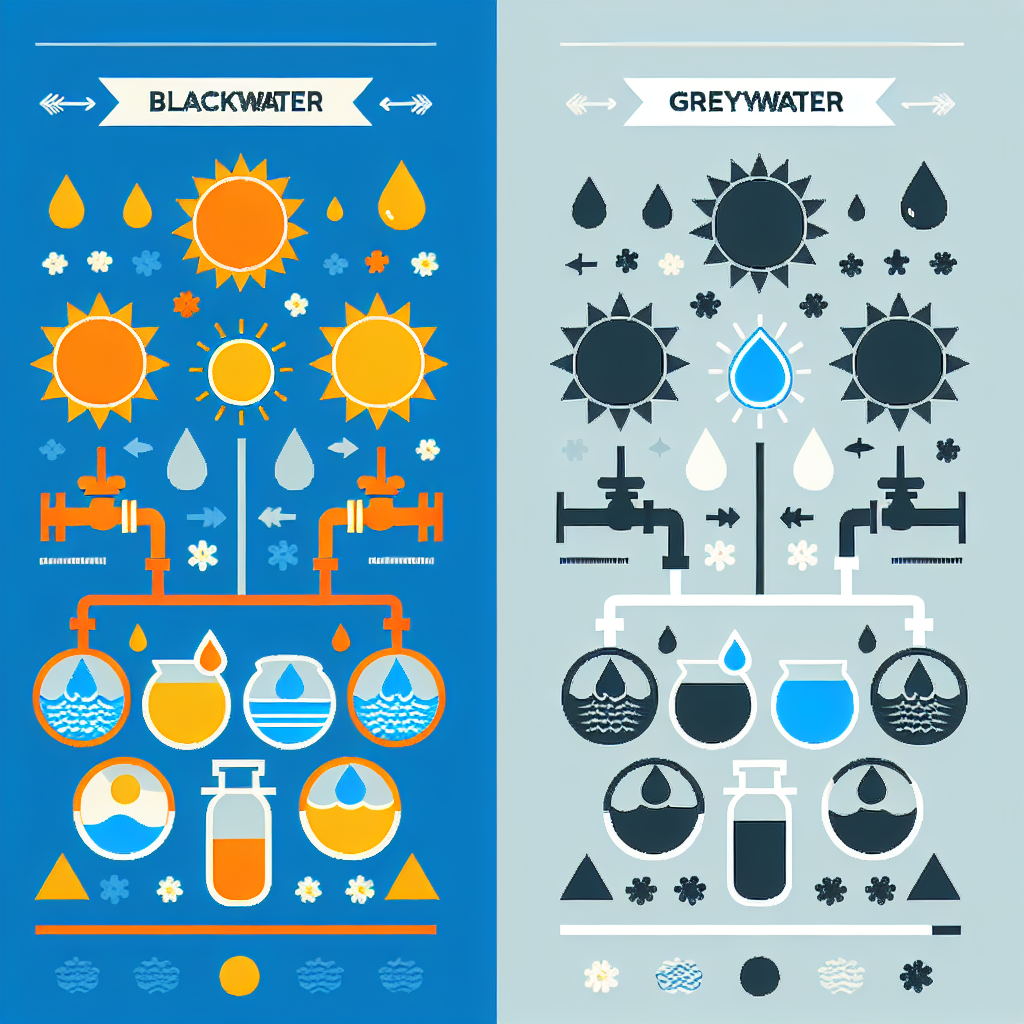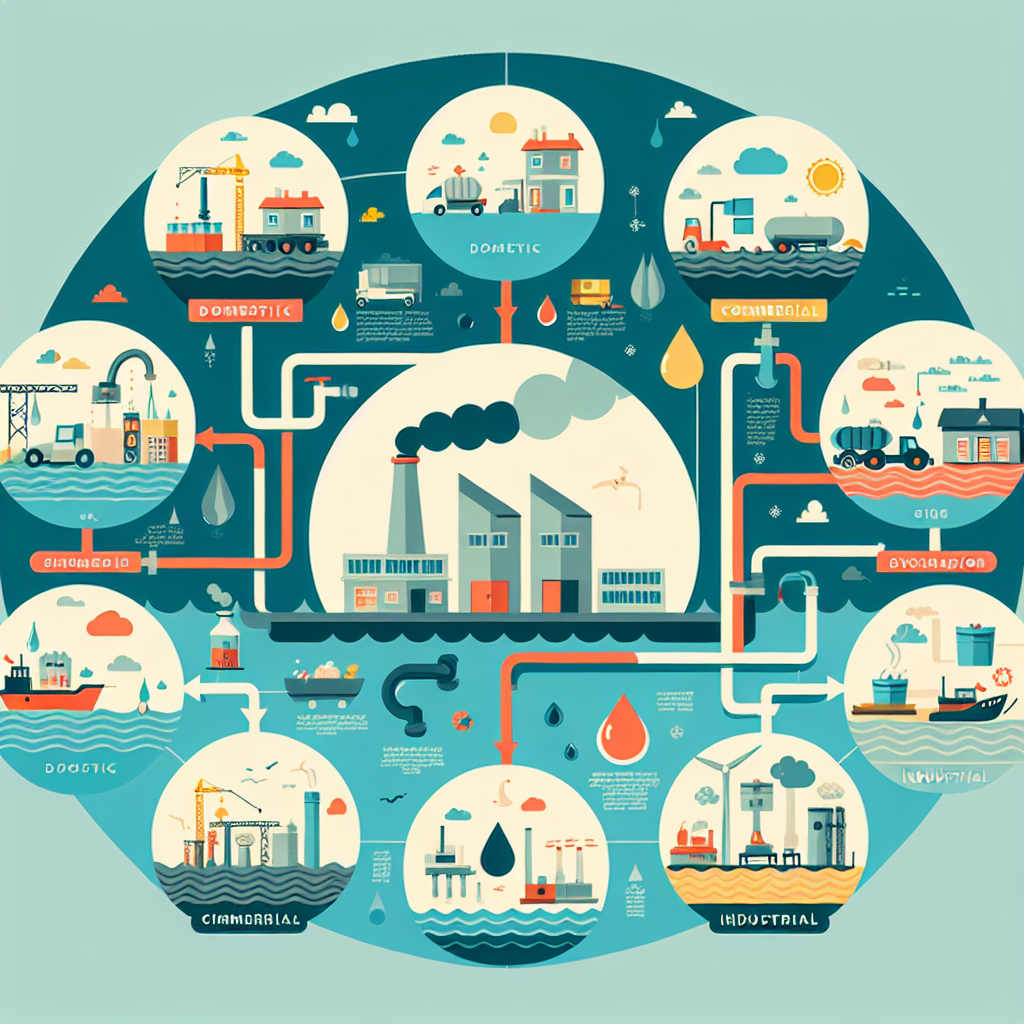Blackwater Explained: Sources, Risks, and Treatment Solutions

Blackwater Explained: Sources, Risks, and Treatment Solutions
Introduction
So, what is blackwater water? If you’re scratching your head, don’t worry you’re not alone! Blackwater is a term that often sends people running for the hills, but it’s time to demystify it. In simple terms, blackwater refers to wastewater that contains human waste and toilet discharge. Think of it as the unsung hero of the wastewater family often misunderstood and rarely appreciated!
To put things into perspective, let’s compare blackwater to its less notorious sibling, greywater. While greywater comes from sinks, showers, and washing machines (basically all the “clean” stuff), blackwater is the result of our more… let’s say, ‘natural’ processes. Understanding this distinction is crucial for effective blackwater management, especially in today’s world where sustainable practices are more important than ever.
The environmental impact of blackwater pollution can be staggering. It’s not just about keeping our toilets flushing; it’s about managing a resource that can be treated and reused through innovative blackwater treatment systems. The importance of treating blackwater cannot be overstated it’s vital for protecting our ecosystems and public health.
Did you know? Properly treated blackwater can be recycled for non-potable uses like irrigation or toilet flushing! Imagine turning that toilet waste into a resource instead of a liability.
In this post, we’ll dive deep into the sources of blackwater, explore the risks associated with its contamination, and discuss cutting-edge treatment solutions that are paving the way for sustainable sanitation practices. Buckle up; it’s going to be an eye-opening ride!
What is Blackwater?
When we talk about what is blackwater water, we’re diving into the murky depths of wastewater that comes directly from our toilets. Yes, it’s the stuff that makes you cringe a little. But fear not! Understanding blackwater is crucial for effective management and treatment.
So, let’s break it down:
- Blackwater definition: Blackwater refers specifically to wastewater that contains human waste, urine, and other contaminants from toilets. It’s like the VIP lounge of wastewater exclusive and a bit more complicated than its less glamorous counterpart.
- Sewage water definition: Sewage water is a broader term that encompasses all types of wastewater, including blackwater and greywater (the latter being water from sinks, showers, and washing machines). Think of it as the entire party versus just the VIPs.
- Types of wastewater: Wastewater can be categorized into several types: blackwater, greywater, and stormwater. Each type has unique characteristics and treatment needs. Understanding these differences is vital for effective blackwater management.
The importance of treating blackwater cannot be overstated. It’s not just about keeping our toilets flushing; it’s also about protecting our environment from potential pollution and health risks associated with untreated sewage. Ignoring this issue could lead to serious consequences for both human health and ecosystems.
Did you know? Blackwater contains pathogens that can pose serious health risks if not treated properly. Effective treatment processes are essential to mitigate these risks.
If you’re wondering how this all fits into the bigger picture of wastewater management, you’re not alone! Many municipalities are grappling with how to handle increasing volumes of household wastewater while ensuring safety and sustainability.
Sources of Blackwater
Now that we’ve tackled what is blackwater water, let’s dive into the nitty-gritty: where does this stuff come from? Spoiler alert: it’s not just your toilet. In fact, blackwater can be sourced from a variety of places, and understanding these sources is key to effective blackwater management and treatment.
Domestic Sources
Your home sweet home is a prime contributor to blackwater. Think about it: every time you flush the toilet or wash your hands, you’re sending a delightful mix of human waste and contaminants down the drain. This includes:
- Toilet waste: The most notorious source, containing pathogens and organic matter.
- Kitchen waste: Food scraps, oils, and greases that can lead to clogs and pollution.
- Bathing water: Hair, soap residues, and personal care products all find their way into the mix.
Commercial Sources
Businesses also play their part in generating blackwater. From restaurants to hotels, these establishments produce significant amounts of sewage due to high foot traffic. Common contributors include:
- Restaurants: Heavy food waste mixed with water creates a potent blackwater cocktail.
- Hotels: With numerous guests showering and flushing away, the volume adds up quickly.
- Cafés and bars: Think about all those coffee grounds and beer spills!
Industrial Sources
If you thought households were the only culprits, think again! Industries contribute their fair share of blackwater as well. Here’s where things get interesting:
- Manufacturing plants: Often discharge water laden with chemicals and heavy metals.
- Agricultural facilities: Waste from livestock operations can introduce pathogens into the water supply.
- Treatment plants: Yes, even they can produce blackwater when treating other types of wastewater!
The environmental impact of blackwater pollution is significant. It can contaminate freshwater sources, harm aquatic life, and pose serious health risks to humans. Understanding these sources helps in developing effective treatment solutions!
Blackwater vs Greywater
When we dive into the world of wastewater, it’s important to distinguish between blackwater and greywater. Think of them as the Batman and Robin of the sanitation universe both are crucial, but they have very different roles.
Definitions and Characteristics
Blackwater, as we’ve established, is the villain in our story it’s the wastewater that comes from toilets, containing human waste and other contaminants. This makes it a prime candidate for serious blackwater treatment processes.
Greywater, on the other hand, is like your friendly neighborhood sidekick. It originates from sinks, showers, and washing machines essentially anything that doesn’t involve a toilet. While it may still contain some contaminants (think soap residue and food particles), it’s generally less hazardous than blackwater.
Differences in Treatment Methods
Treating these two types of wastewater requires different approaches:
- Blackwater Treatment: This often involves more complex methods such as anaerobic digestion or advanced filtration systems to eliminate pathogens effectively.
- Greywater Treatment: Typically simpler, greywater can often be treated using basic filtration or biological processes before being reused for irrigation or flushing toilets.
Environmental Impact Comparison
The environmental impact of blackwater versus greywater is substantial. Blackwater poses a higher risk of contamination if not treated properly. It can lead to serious issues like:
- Eutrophication: Excess nutrients from untreated blackwater can cause algal blooms in water bodies.
- Pathogen Spread: Improper disposal can lead to waterborne diseases.
In contrast, greywater recycling can actually reduce freshwater consumption and provide benefits to landscaping. However, it’s essential to ensure that any contaminants are adequately filtered out before reuse.
Key Takeaway: Understanding the differences between blackwater and greywater is crucial for effective wastewater management. Each type requires tailored treatment solutions to mitigate risks and maximize environmental benefits.
Risks and Contamination from Blackwater
So, what is blackwater water, and why should we care about it? Well, imagine a toxic cocktail of human waste, food scraps, and various household chemicals swirling together in a dark abyss. That’s blackwater for you! This type of wastewater is not just your average spill; it comes with its own set of risks and contamination concerns that can make even the bravest sanitation worker shudder.
Health Risks Associated with Blackwater Pollution
First off, let’s talk health. Blackwater is a breeding ground for harmful bacteria, viruses, and pathogens. Exposure can lead to serious health issues such as:
- Gastrointestinal infections
- Respiratory illnesses
- Skin infections
- Hepatitis A
The risk escalates significantly in areas where blackwater is improperly managed or disposed of. Think about it: if untreated blackwater seeps into the groundwater or nearby water bodies, it can contaminate drinking water sources yikes!
Environmental Impact of Blackwater Contamination
The environmental impact of blackwater pollution is equally alarming. When released into ecosystems without treatment, it wreaks havoc on aquatic life:
- Nutrient overload: Excess nutrients from blackwater can lead to algal blooms, which deplete oxygen in water bodies.
- Ecosystem disruption: The introduction of pathogens can decimate wildlife populations.
- Soil contamination: Blackwater can alter soil chemistry and adversely affect plant growth.
Sewage vs Blackwater: Understanding the Differences in Risk Profiles
You might be wondering how sewage differs from blackwater. While both are types of wastewater, the key difference lies in their content:
| Type | Description | Risk Level |
|---|---|---|
| Sewage | A mixture of human waste and greywater (from sinks, showers) | Moderate to High |
| Blackwater | Mainly toilet waste water containing human feces and urine | High to Very High |
The takeaway here is clear: understanding what is blackwater water isn’t just an academic exercise; it’s crucial for public health and environmental safety. By recognizing the risks associated with blackwater contamination, municipalities and engineers can implement better management strategies to protect both people and nature.
If you’re involved in wastewater treatment or management, staying informed about these risks will empower you to make more effective decisions regarding blackwater treatment solutions.
Treatment Solutions for Blackwater
So, what is blackwater water? It’s the not-so-glamorous byproduct of our daily lives, mainly consisting of toilet waste and other organic materials. But fear not! There are effective treatment solutions to tackle this smelly foe.
Overview of Blackwater Treatment Processes
Treating blackwater is essential for both environmental safety and public health. The treatment processes can be broken down into several key stages:
- Preliminary Treatment: This involves screening out large solids and debris that could clog systems.
- Primary Treatment: Here, the blackwater undergoes sedimentation to separate solids from liquids.
- Secondary Treatment: This step uses biological processes, often involving bacteria, to break down remaining organic matter.
- Tertiary Treatment: The final polish! Advanced filtration methods ensure that any remaining contaminants are removed, making the water safe for disposal or reuse.
The Role of Bacteria in Breaking Down Contaminants
You might think bacteria are bad news, but in the world of blackwater treatment, they’re the unsung heroes! These microscopic organisms feast on organic materials, breaking them down into simpler compounds. Think of them as tiny recyclers working tirelessly to keep our water clean.
Did you know? Effective blackwater treatment can reduce contaminants by up to 90%, making it a critical part of wastewater management!
Technologies for Recycling Household Wastewater
The future is bright (and a bit less smelly) with innovative plumbing solutions designed for eco-friendly sanitation practices. Here’s a peek at some technologies making waves in blackwater recycling:
- Aerobic Treatment Units (ATUs): These systems use oxygen to promote bacterial growth that breaks down waste more efficiently than traditional septic systems.
- Constructed Wetlands: A natural approach where plants and soil filter contaminants while providing a habitat for beneficial microorganisms.
- Membrane Bioreactors (MBRs): Combining biological treatment with membrane filtration, MBRs produce high-quality effluent suitable for reuse in irrigation or even toilet flushing!
The battle against blackwater pollution is not just about managing waste; it’s about embracing sustainable practices that benefit both our communities and the environment. By investing in effective blackwater treatment solutions today, we pave the way for a cleaner tomorrow!
Blackwater Management Strategies
When it comes to understanding what is blackwater water, managing it effectively is crucial for both public health and environmental sustainability. Think of blackwater management as the superhero of wastewater treatment saving the day from contamination and pollution!
Sustainable Water Management Practices for Homes
Homeowners can play a pivotal role in blackwater management by adopting sustainable practices. Here are some strategies that can help:
- Install low-flow toilets: These beauties use less water, which means less blackwater generated.
- Regular maintenance: Keep your septic systems in tip-top shape to avoid costly failures.
- Use eco-friendly products: Opt for biodegradable soaps and cleaners to reduce harmful chemicals in your blackwater.
- Implement composting toilets: Yes, they exist! These toilets turn human waste into compost, minimizing blackwater production.
Septic Systems and Blackwater Management Challenges
Septic systems are often the unsung heroes of rural waste management. However, they come with their own set of challenges:
- Lack of awareness: Many homeowners don’t realize how their actions impact septic system performance. For instance, flushing non-biodegradable items can lead to major clogs.
- Pumping frequency: Neglecting regular pumping can lead to system failure and costly repairs.
- Environmental regulations: Keeping up with local regulations regarding blackwater disposal can be a headache, but it’s essential for community health.
Key Takeaway: Effective blackwater management is not just about treatment; it’s about prevention. By adopting sustainable practices and understanding your septic system, you contribute to a healthier environment!
The Importance of Treating Blackwater
So, what is blackwater water and why should we treat it? Imagine your home as a bustling café, where every cup of coffee brewed translates to a flush of water. That’s right, blackwater is essentially the toilet waste water explanation for the more unsavory side of our daily routines! But here’s the kicker: if we don’t treat this type of wastewater properly, we’re not just risking our plumbing; we’re also endangering public health and the environment.
First off, let’s break down some of the key reasons why treating blackwater is crucial:
- Health Risks: Untreated blackwater can harbor harmful pathogens that pose serious health threats. Think about it: no one wants to deal with bacteria that could lead to gastrointestinal issues or worse!
- Environmental Protection: Proper treatment prevents blackwater pollution from seeping into our waterways, which can disrupt aquatic ecosystems. It’s like putting a dam in front of a flood you’re protecting both wildlife and human communities.
- Sustainable Practices: By investing in blackwater treatment solutions, municipalities can recycle and reuse this resource. Yes, you read that right! Treated blackwater can be repurposed for irrigation or industrial processes talk about turning waste into a valuable commodity!
- Avoiding Legal Complications: There are strict regulations surrounding wastewater disposal. Failing to comply can lead to hefty fines. Think of it as paying your taxes nobody enjoys it, but it’s necessary!
Did You Know? According to recent studies, effective blackwater management can reduce overall wastewater treatment costs by up to 30% while improving local environmental conditions.
Challenges in Treating Blackwater
Treating blackwater isn’t all rainbows and sunshine; there are challenges too! For instance:
- Diverse Contaminants: Blackwater contains a cocktail of contaminants including human waste, soaps, and chemicals, making treatment complex.
- Bacterial Balance: The role of bacteria in breaking down these contaminants is vital but tricky too few or too many can throw off the entire system.
- Cultural Attitudes: There’s often stigma associated with using treated blackwater for irrigation or other purposes. Changing public perception takes time and education.
Safe Disposal Options for Treated Blackwater
The final goal? Safe disposal! When done right, treated blackwater can be released back into the environment without causing harm. Here are some options:
- Irrigation Systems: Use treated water for landscaping or agricultural purposes.
- Industrial Reuse: Many industries are now employing treated blackwater for cooling processes or even as raw material in manufacturing.
- Direct Discharge: In some cases, after thorough treatment, it can be safely discharged into water bodies.
- < li >Safe disposal options for treated blackwater
- < / ul >
< / section >< section >
Uses of Treated Blackwater< / h 2 > - Recycling and reuse applications
-
< / ul >
< / section >< section >
Conclusion< / h 2 >
< / section >






